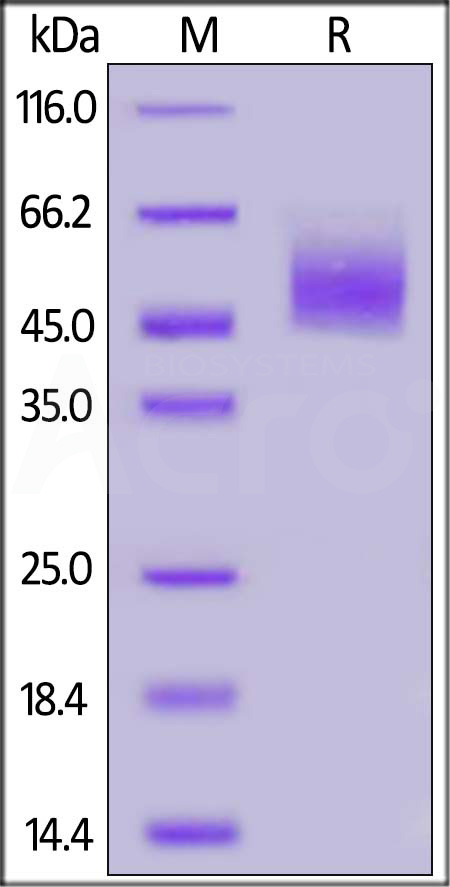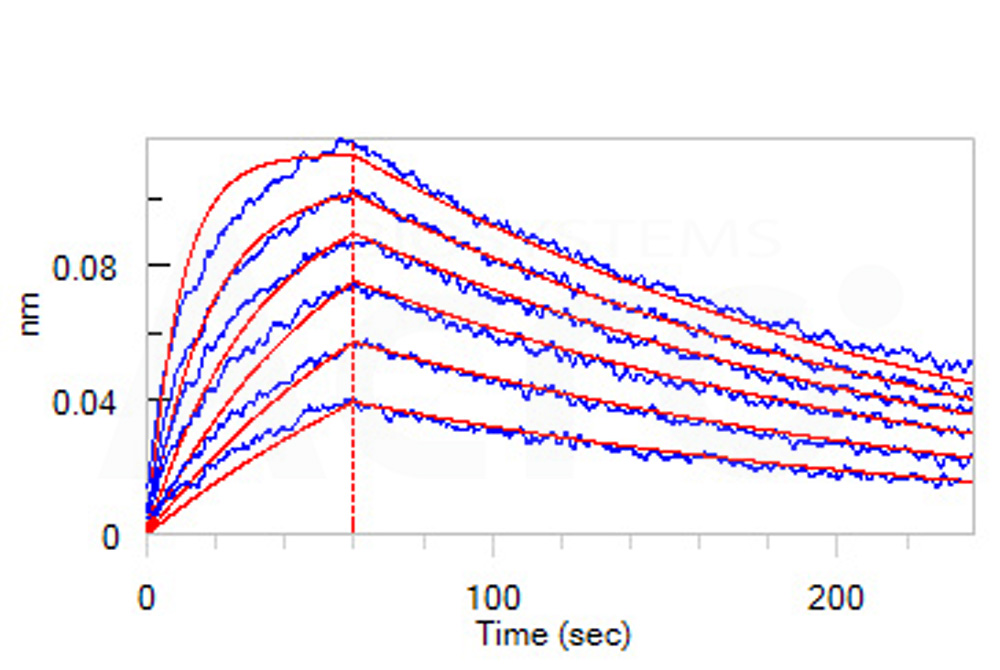分子别名(Synonym)
CRTAM,CD355
表达区间及表达系统(Source)
Human CRTAM, His Tag (CRM-H52H3) is expressed from human 293 cells (HEK293). It contains AA Ser 18 - Gly 287 (Accession # O95727-1).
Predicted N-terminus: Ser 18
Request for sequence
蛋白结构(Molecular Characterization)

This protein carries a polyhistidine tag at the C-terminus.
The protein has a calculated MW of 31.9 kDa. The protein migrates as 45-66 kDa under reducing (R) condition (SDS-PAGE) due to glycosylation.
内毒素(Endotoxin)
Less than 1.0 EU per μg by the LAL method.
纯度(Purity)
>90% as determined by SDS-PAGE.
制剂(Formulation)
Lyophilized from 0.22 μm filtered solution in PBS, pH7.4. Normally trehalose is added as protectant before lyophilization.
Contact us for customized product form or formulation.
重构方法(Reconstitution)
Please see Certificate of Analysis for specific instructions.
For best performance, we strongly recommend you to follow the reconstitution protocol provided in the CoA.
存储(Storage)
For long term storage, the product should be stored at lyophilized state at -20°C or lower.
Please avoid repeated freeze-thaw cycles.
This product is stable after storage at:
- -20°C to -70°C for 12 months in lyophilized state;
- -70°C for 3 months under sterile conditions after reconstitution.
质量管理控制体系(QMS)
电泳(SDS-PAGE)

Human CRTAM, His Tag on SDS-PAGE under reducing (R) condition. The gel was stained with Coomassie Blue. The purity of the protein is greater than 90%.
活性(Bioactivity)-BLI

Loaded Human CRTAM, His Tag (Cat. No. CRM-H52H3) on AR2G Biosensor, can bind Human CADM1, His Tag (Cat. No. CA1-H5225) with an affinity constant of 51.1 nM as determined in BLI assay (ForteBio Octet Red96e) (Routinely tested).
Protocol

- 416XXXXXXX63
- I used recombinant protein L from ACROS Biosystems to prepare gold conjugates for immunosensors and rapid quantification of human IgG and was able to detect 2.5 ng of Human IgG in less than 1 minute. I highly recommend this product for the detection and isolation of antibodies and Fab'2 fragments. I will definitely be ordering this item again.
- 2021-10-3
背景(Background)
Class I-restricted T cell-associated molecule (CRTAM), a member of nectin family and the immunoglobulin superfamily, is also known as cytotoxic and regulatory T-cell molecule, which is expressed by activated CD8+ and NK T cells. CRTAM is found in spleen, thymus, small intestine, peripheral blood, and surprisingly, in brain where it is highly expressed by Purkinje cells of the cerebellum. The high affinity of CRTAM/IGSF4 adhesion allows CRTAM to disrupt IGSF4 homotypic interactions (3 - 5). IGSF4 and T cell receptor co-engagement of CRTAM-expressing CD8+ cells induces increased IFN-gamma or IL-22 production (3, 4). Furthermore, a role in cancer surveillance through NK cell-mediated rejection of IGSF4-expressing tumors has been proposed.























































 膜杰作
膜杰作 Star Staining
Star Staining












 Loading ...
Loading ...




